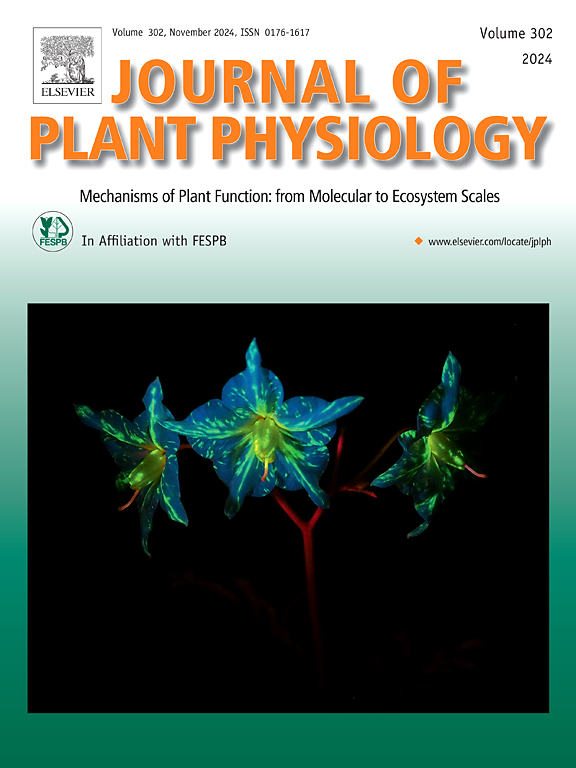Humboldt review: The role of Ancestral MicroRNAs in grass inflorescence development
IF 4
3区 生物学
Q1 PLANT SCIENCES
引用次数: 0
Abstract
Plant inflorescences are complex, highly diverse structures whose morphology is determined in meristems that form during reproductive development. Inflorescence structure influences flower formation, and consequently grain number, and yield in crops. Correct inflorescence and flower development require tight control of gene expression via complex interplay between regulatory networks. MicroRNAs (miRNAs) have emerged as fundamental modulators of gene expression at the transcriptional and/or post-transcriptional level in plant inflorescence development. First discovered more than three decades ago, miRNAs have proved to be revolutionary in advancing our mechanistic understanding of gene expression. This review highlights current knowledge of downstream target genes and pathways of some highly conserved miRNAs that regulate the maintenance, identity, and activity of inflorescence and floral meristems in economically and agriculturally important grass species, including rice (Oryza sativa), maize (Zea mays), barley (Hordeum vulgare), and wheat (Triticum aestivum). Furthermore, we summarize emerging regulatory networks of miRNAs and their targets to suggest new avenues and strategies for application of miRNAs as a tool to enhance crop yield and performance.
祖先microrna在草花序发育中的作用。
植物花序结构复杂,种类繁多,其形态由生殖发育过程中形成的分生组织决定。花序结构影响花的形成,进而影响谷物的数量和农作物的产量。花序和花的正确发育需要通过调控网络之间复杂的相互作用来严格控制基因表达。微小核糖核酸(miRNA)已成为植物花序发育过程中转录和/或转录后水平基因表达的基本调节因子。三十多年前,miRNAs 首次被发现,事实证明,它在推进我们对基因表达机理的理解方面具有革命性的意义。本综述重点介绍了目前对一些高度保守的 miRNA 的下游靶基因和途径的了解,这些 miRNA 调控着水稻(Oryza sativa)、玉米(Zea mays)、大麦(Hordeum vulgare)和小麦(Triticum aestivum)等具有重要经济和农业价值的禾本科植物的花序和花分生组织的维持、特性和活性。此外,我们还总结了新出现的 miRNA 及其靶标调控网络,为应用 miRNA 作为提高作物产量和性能的工具提出了新的途径和策略。
本文章由计算机程序翻译,如有差异,请以英文原文为准。
求助全文
约1分钟内获得全文
求助全文
来源期刊

Journal of plant physiology
生物-植物科学
CiteScore
7.20
自引率
4.70%
发文量
196
审稿时长
32 days
期刊介绍:
The Journal of Plant Physiology is a broad-spectrum journal that welcomes high-quality submissions in all major areas of plant physiology, including plant biochemistry, functional biotechnology, computational and synthetic plant biology, growth and development, photosynthesis and respiration, transport and translocation, plant-microbe interactions, biotic and abiotic stress. Studies are welcome at all levels of integration ranging from molecules and cells to organisms and their environments and are expected to use state-of-the-art methodologies. Pure gene expression studies are not within the focus of our journal. To be considered for publication, papers must significantly contribute to the mechanistic understanding of physiological processes, and not be merely descriptive, or confirmatory of previous results. We encourage the submission of papers that explore the physiology of non-model as well as accepted model species and those that bridge basic and applied research. For instance, studies on agricultural plants that show new physiological mechanisms to improve agricultural efficiency are welcome. Studies performed under uncontrolled situations (e.g. field conditions) not providing mechanistic insight will not be considered for publication.
The Journal of Plant Physiology publishes several types of articles: Original Research Articles, Reviews, Perspectives Articles, and Short Communications. Reviews and Perspectives will be solicited by the Editors; unsolicited reviews are also welcome but only from authors with a strong track record in the field of the review. Original research papers comprise the majority of published contributions.
 求助内容:
求助内容: 应助结果提醒方式:
应助结果提醒方式:


